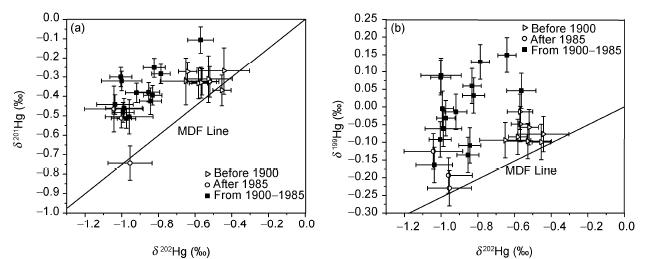
Figure MIF of 199Hg and 201Hg for all peat samples.
High-precision Pb-210 dating technology was applied to a peat core with a time span of about 150 years that was taken from Hongyuan, Sichuan Province, China. The concentrations of total mercury (Hg) and stable isotope compositions of mercury in the peat core were measured using a LUMEX 915 instrument and multi-collector inductively coupled plasma mass spectrometer, respectively. Total mercury (Hg) concentrations in the peat core had a clearly increasing trend from the bottom to top of the core while delta Hg-202 values (relative to NIST 3133) of peat had a decreasing trend. The total mercury (Hg) concentration varied from 16.7 to 101.3 ng/g and the delta Hg-202 values ranged from -0.44aEuro degrees +/- 0.14aEuro degrees to -1.45aEuro degrees +/- 0.22aEuro degrees. We clearly show that the study area experienced mercury pollution after the industrial revolution, and the mercury emitted from natural sources and anthropogenic sources had different Hg isotope signatures.
| Publication name |
CHINESE SCIENCE BULLETIN Volume: 56 Issue: 9 Pages: 877-882 Published: MAR 2011 |
| Author(s) |
Shi WenFang; Feng XinBin; Zhang Gan; Ming LiLi; Yin RunSheng; Zhao ZhiQi; Wang Jing |
| Corresponding author |
FENG Xinbin
fengxinbin@vip.skleg.cn
Chinese Acad Sci, State Key Lab Environm Geochem, Inst Geochem, Guiyang 550002, Peoples R China |